As detailed in my gameplay review, EA Sports UFC 3 is a fun yet flawed MMA brawler, and while the gameplay is the meat and potatoes of any video game, the garnish comes in the form of different modes. In recent years, sports games have undergone a transition from simple stat tracking and seasons to full-on narrative experiences as seen in the NBA 2K series and Madden NFL 18’s Longshot.
With the explosion in popularity of the Notorious Conor McGregor, EA looked to capture what makes McGregor so compelling inside the Octagon and out. What results is a career mode that manages to trim some of the fat from its predecessors, while also adding immersion and purpose to your fighter’s journey towards becoming the greatest of all time.
That’s not to say there aren’t improvements to be made, but this is a good first step towards something truly special.
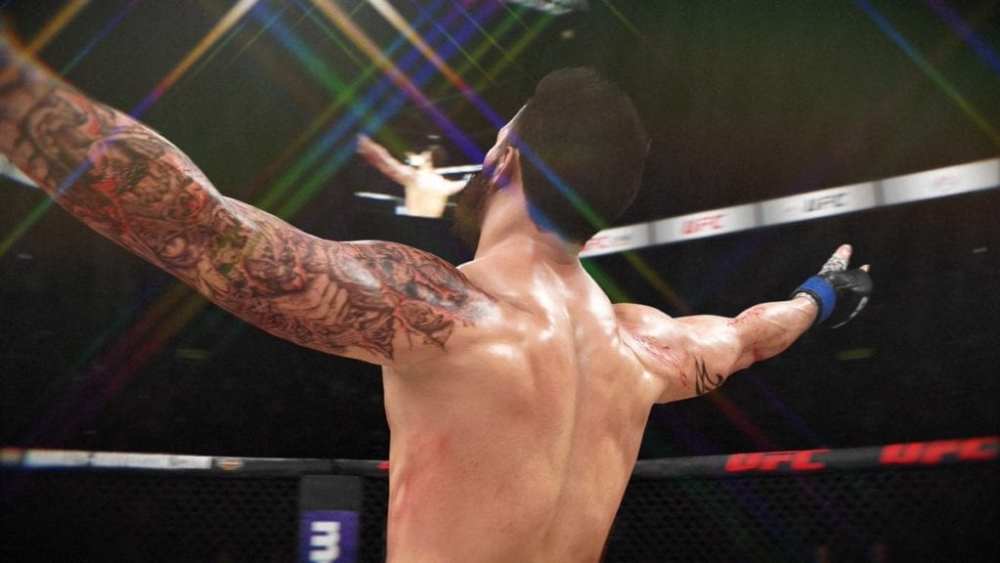
Getting Started
Starting off, players can import an existing UFC fighter and attempt to rewrite their career. Name and appearance are the only things that get imported into career so stats, moves and perks for these imported fighters are set to the same as a custom fighters. This is a fun option as it allows for a bit of revisionist history.
Now, if you hated that Cormier never beat Jones, you’ll have a chance to rewrite those losses. In the real world, it would be laughable for CM Punk to ever get a shot at the UFC welterweight championship, but I will attempt to do that in a multi-part series on Operation Sports in the near future.
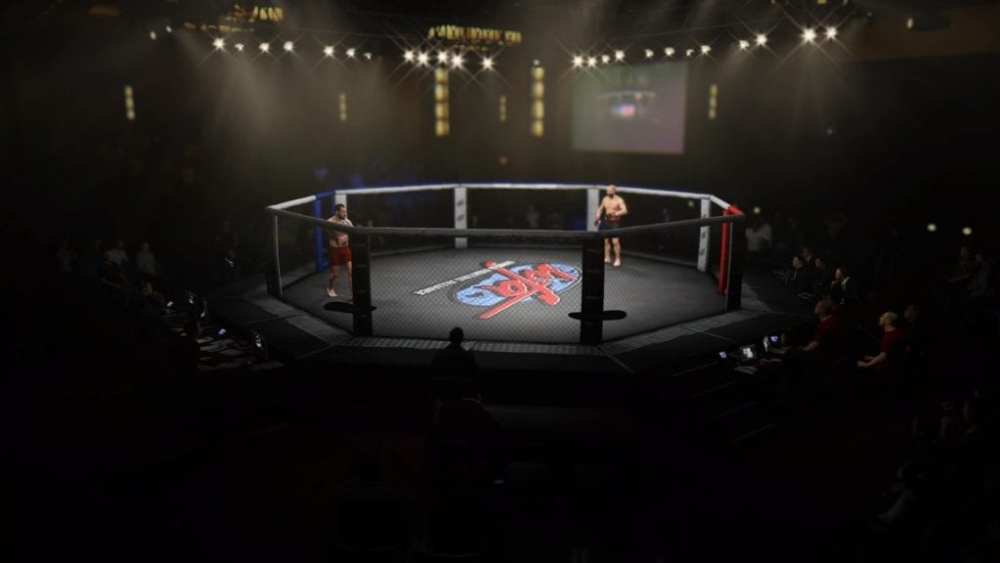
On the other hand, if you want to make a fighter from scratch, you can choose either a male or female fighter to create. While it’s disappointing that the creation suite is largely unchanged from EA Sports UFC 2, there are enough options to create a wide variety of fighters.
You can even import your image onto your fighter via Gameface, but I could never get it right. It might’ve been due to my beard but I was forced to try and create something close to looking like my face using the in-game tools.
After choosing a fighter, weight class, fighting style, and difficulty level are all done, players sign their first contract with the World Fighting Alliance and are treated to a video package in the style of UFC Countdown. After completing the first fight with the WFA, players are taken to the main hub of career mode.
From here players can accept fight offers, edit appearance, perks, and moves, keep track of their ranking in their division, and keep track of the milestones required to become the greatest of all time in the UFC. To become the G.O.A.T. players must break six fight records such as most wins in the UFC, most title defenses, most knockouts, and two promotional records that center around fan following or Pay-Per-View buys.
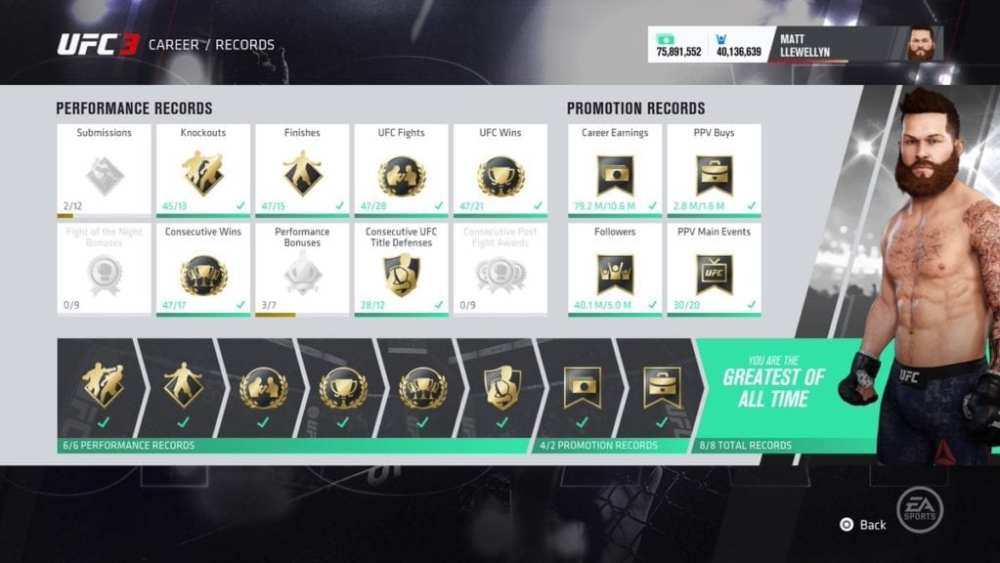
Building Your Character
To accomplish this, players must split their time, 100 points per week, between training for fights and promoting themselves to the public. Each action costs a different number of points and each fight has a different camp length leading up to the fight.
When training for a fight, fitness level is important. Starting at low fitness, completing training tasks improve fitness levels so that fighters reach peak fitness by fight night. One thing to be mindful is taking rests as it is possible to go into a fight over-trained. Being under or over-trained can impact your fighter’s stamina going into the next fight.
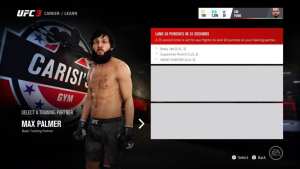
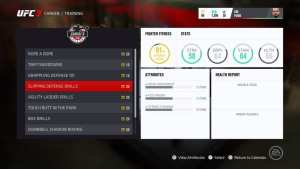


After accepting a fight, players choose their fight camp. Fight camps have different specialties, and have different moves and perks for the players to unlock. Both are unlocked by training with a specific fighter and completing a specific drill. The better the gym, the better the trainer — though they are unlockable based on income and prestige level.
Don’t expect to get lessons from Michael Bisping or Georges St-Pierre while still relegated to the undercard. The drills themselves are fairly easy and don’t take too much time to do. Most of the time they are along the lines of hitting a certain amount of kicks in a set time frame or doing a certain amount of damage to a specific body part.
Sparring can give players tips on their upcoming opponents and can help reach peak fitness very quickly. Indeed, I usually would save at least one sparring session for the end so that if I did a lot of fan promotion, I was still able to get into peak fitness just by doing a single one-minute sparring round.
The tips are somewhat helpful, but it’s the fact that sparring gives way too much fitness that makes it truly useful. It takes away some of the balancing between training and promoting that this mode was really advertised as being centered on. Getting hurt in sparring can affect your fitness negatively, but since you gain fitness even when running away the instances of getting hurt are few and far between.
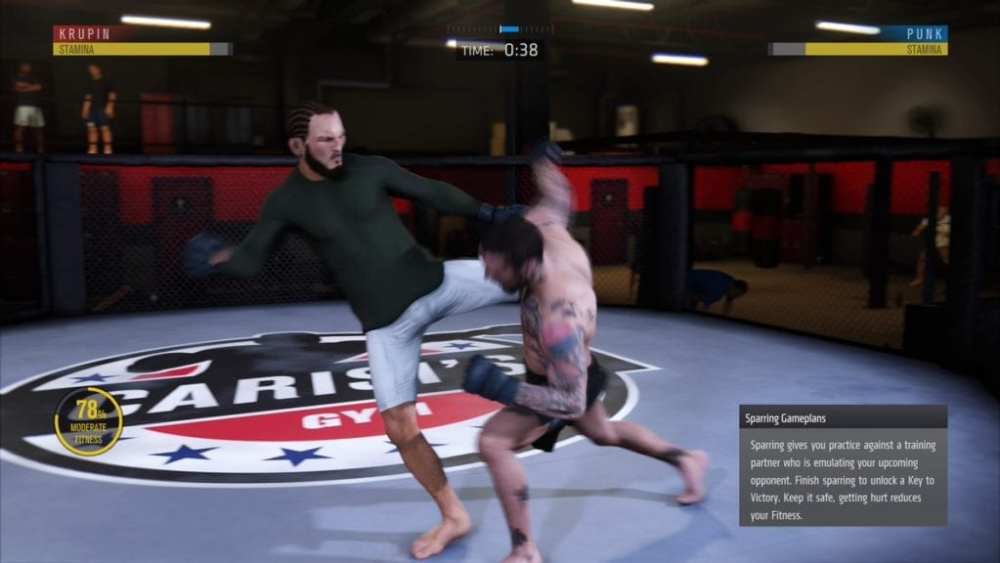
Training
Training attributes has been narrowed down to a menu full of drills that improve attributes relating to one of four attribute categories: Striking, Grappling, Stamina and Health. You don’t have to manually do heavy bag drills anymore, or quick strike drills. Instead, while the wear and tear system and injury system remain the same, making attributes trainable by simming via a menu makes the process more streamlined. Where that less is more approach falls apart is in the rivalry and promotion systems.
Outside of the Octagon
Before release, multiple screenshots and clips were shown of press conference and weigh-in showdowns, but sadly these are also relegated to cutscenes and menus. Promoting a fight is as simple as spending points on a promotional task like streaming a game for fans or attending a UFC event, but there really is no player agency beyond choosing the task and getting a message from fans about it.
Similarly, the rivalry system is done via a Twitter-like interface where an opposing fighter sends a mean tweet your way and you choose one of three ways to respond. There’s no way to choose your rival and there is no lasting fallout from a rivalry. While you can’t train at a rival’s gym while in the rivalry, that gym opens up to you again afterwards.
While disappointing that there are not more choices or consequences when promoting fights, the groundwork is here for something more exciting and immersive, and I hope that the team at EA can expand upon a good first step in the next UFC game.
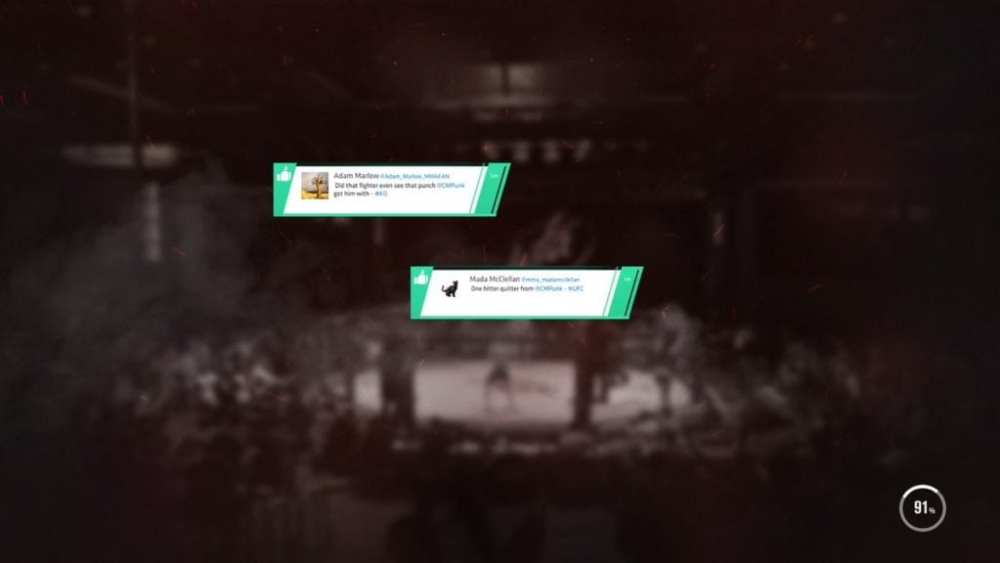
A Huge Difficulty Spike
As you increase in rank and get better and better contracts, the difficulty spikes by a large degree. Despite the game warning me during loading screens, I was taken aback by just how hard it was to fight against top 10 fighters.
While fighting the best of the best should be harder, I feel that a more gradual difficulty increase is warranted. I went from knocking out the number 11 fighter in the first round to having an absolute war against the 9th ranked fighter, and the CPU seemingly knew everything that I was doing.
Again, I appreciated being forced to fight so much more intelligently than I had to at lower ranks, but there needs to be more of a lead up to it instead of it being so sudden from one fight to the next.
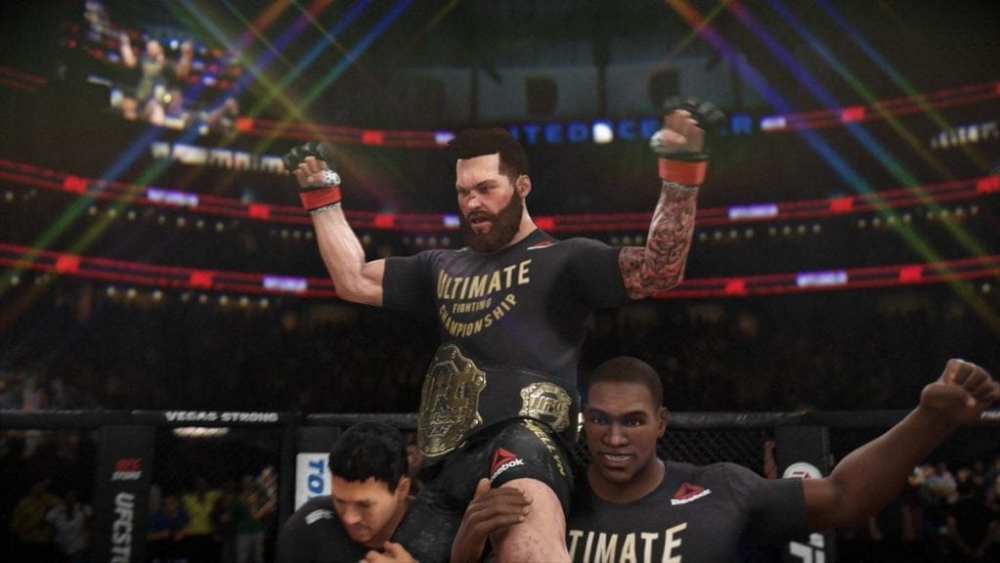
But The Long-Term Is Iffy
After winning the UFC title, players will then be set on a path to have a super fight with the champion of another division. At this point, players will be close to achieving all of the milestones to become the G.O.A.T. — though all of this must be accomplished before the longevity meter on a fighter’s career runs out.
Taking damage causes it to go down faster than finishing fights quickly, and it’s towards this endgame that the experience becomes a bit of the same old thing. After having reached the greatest of all time status, I was given the opportunity to retire right away or fight until my longevity ran out.
Not knowing that there was no option to manually retire afterwards, I chose to keep going. This led to the problem of fighting a 54-year-old Matt Brown and a 48-year-old Anthony Pettis. It just kills the immersion to not have more created fighters take over for the real life ones, and it makes the idea of a longevity meter weird considering the real fighters never retire.
Final Thoughts
The career mode in EA Sports UFC 3 is more streamlined and more fun than UFC 2’s career mode in just about every way. The narrated cutscenes and Twitter-like feed are nice touches that add more to the experience than simply picking fights and grinding training drills.
Unlike past games, the art of training has been simplified so that the focus is on the core gameplay rather than repetitive drilling. While the promotion and rivalry systems are underwhelming, there is a ton of potential for future releases if the team at EA decides to expand upon the choices that players can make.
Despite some quirks and missteps, the career mode in UFC 3 is a good first step towards creating a completely immersive experience.








Published: Feb 5, 2018 09:18 pm